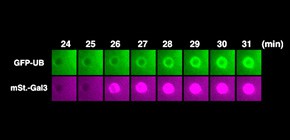
Elucidation of cellular mechanism for removing invading pathogens
clarification of important role ubiquitin plays
A group of researchers led by Professor Tamotsu YOSHIMORI and former Assistant Professor Naonobu FUJITA of the Graduate School of Frontier Biosciences and Graduate School of Medicine, Osaka University, have clarified a mechanism in which intracellular pathogens are degraded by autophagy. Autophagy is a mechanism involving cellular degradation of unnecessary cellular components and making use of autophagosomes.
In 2004, in a world first, a group of researchers led by Professor YOSHIMORI discovered that invading pathogens were degraded by autophagy. Since then the degradation of a variety of pathogens has been reported, but how cells go about identifying pathogens was unknown.
This time, the group succeeded in showing how ubiquitin was involved in the process of sequestering invading bacteria.
This group's achievement in elucidating the important role ubiquitin plays in the autophagic response to invading pathogens is a great step in understanding mechanisms behind infectious diseases, cancer, diabetes, and more.
Abstract
Although ubiquitin is thought to be important for the autophagic sequestration of invading bacteria (also called xenophagy), its precise role remains largely enigmatic. Here we determined how ubiquitin is involved in this process. After invasion, ubiquitin is conjugated to host cellular proteins in endosomes that contain Salmonella or transfection reagent-coated latex (polystyrene) beads, which mimic invading bacteria. Ubiquitin is recognized by the autophagic machinery independently of the LC3-ubiquitin interaction through adaptor proteins, including a direct interaction between ubiquitin and Atg16L1. To ensure that invading pathogens are captured and degraded, Atg16L1 targeting is secured by two backup systems that anchor Atg16L1 to ubiquitin-decorated endosomes. Thus, we reveal that ubiquitin is a pivotal molecule that connects bacteria-containing endosomes with the autophagic machinery upstream of LC3.
Figure 1
Figure 2
To learn more about this research, please read the full research report entitled " Recruitment of the autophagic machinery to endosomes during infection is mediated by ubiquitin " at this page of the Journal of Cell Biology website.
Related link :

